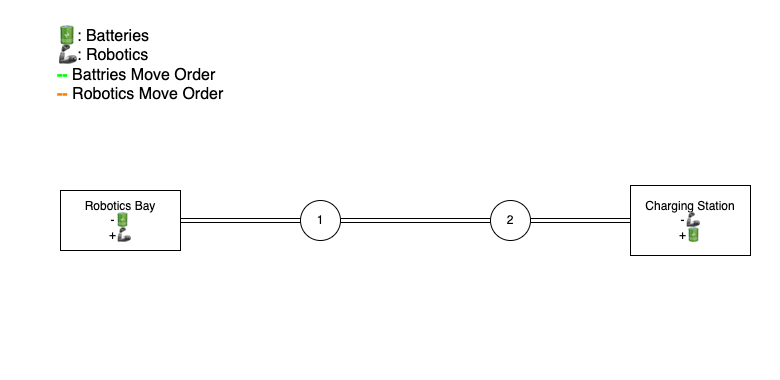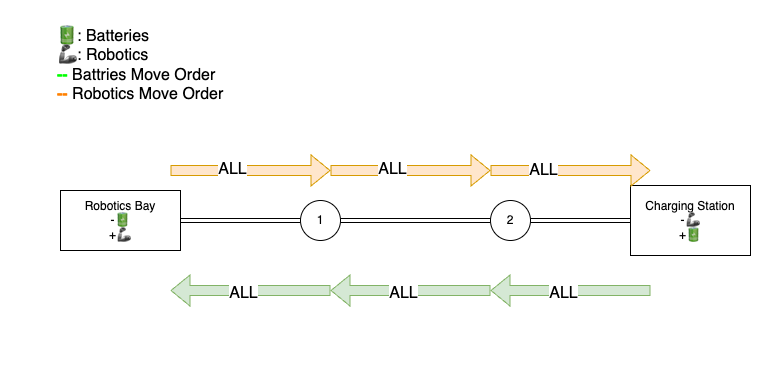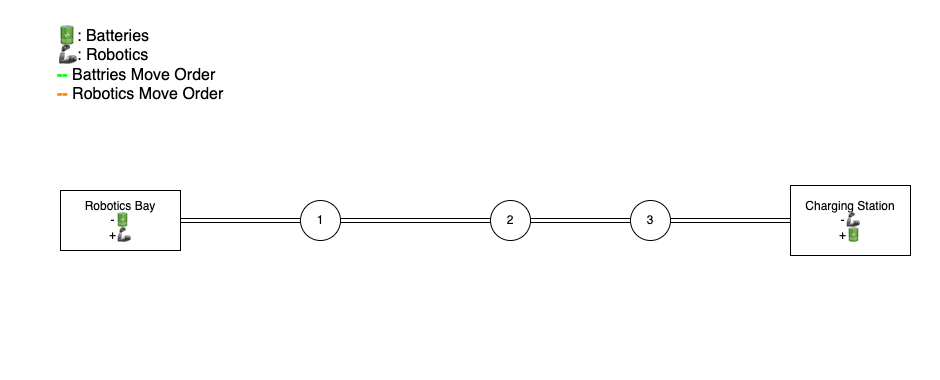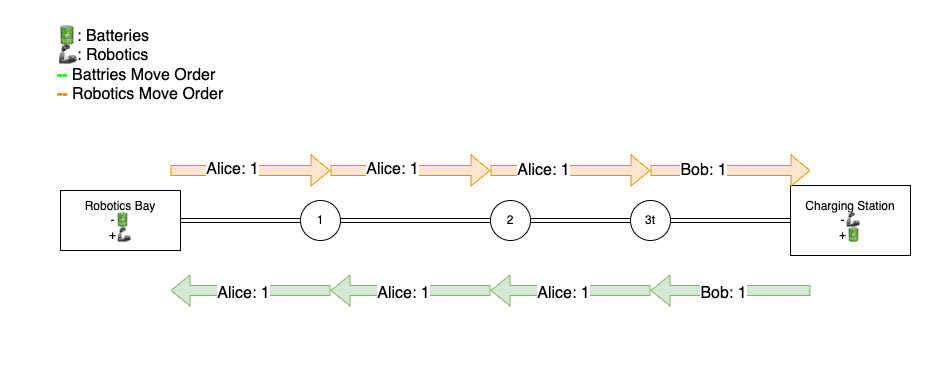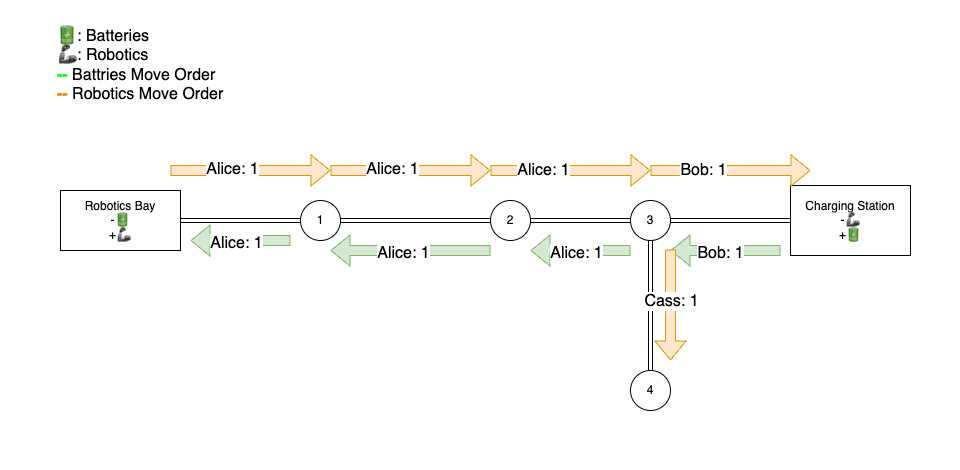Logistics
The resources of the underground can support the people of The Underground. Barely. And only when they are in the right place at the right time.
Players interested in leaning into themes of expansionism, scarcity and resource misallocation and the lies it is built on can do so with the logistics mechanics of Terminus. This is not the only way to engage with these themes, and players should be able to have complete and satisfying experiences without ever touching the logistics mechanics. This said, characters in the logistics game will have the opportunity to see The Underground thrive or falter because of their successes and failures in managing its limited resources.
Most of the functions necessary to sustain life in The Underground are automated, either through dedicated machinery or the use of simple robots. The robots of The Underground are considerably more advanced than those of 2023, capable of performing general tasks of moderate dexterity and adaptable enough to be programmed by a single person to do so. That said, the Robots of the underground are still relatively clumsy compared to its humans, and none could be described as remotely intelligent. Tasks that require creativity and finesse, such as repairing machinery or manoeuvring through cave systems, are well beyond them.
Becoming Involved in Logistics
Players who wish to begin the game already embedded in the logistics mechanics can do so via taking the Scheduler quirk. Players who do not want to begin the game with quirks supporting these mechanics, for example because they are unsure if they will enjoy them, will still have opportunities to become involved in logistics in play, either by acquiring the Quirk through becoming involved in logistics in character or indirectly by turnsheeting actions which will have consequences for the logistics game.
By acquiring appropriate narrative positioning in game, such as being elected to powerful civic positions, players will also be able to acquire Quirks that interact with the logistics mechanics like the ones that can be taken in character creation, listed here.
How Logistics Works
The basic play of logistics is as follows:
- Before uptime the GMs determine which Move Orders NPCs schedule
- During uptime and emails players discover NPC Move Orders and coordinate which Move Orders to schedule
- Players schedule Move Orders as part of their turnsheet, and include how they use quirks such as Veto
- The GMs determine whether player turnsheet actions interfere with scheduled Move Orders
- The GMs resolve the Network and decide which stops' Needs are unmet if appropriate
Terms in bold are further explained in the following section.
The Core Elements of Logistics
Needs and Resources
The most basic elements of the logistics game are Needs and Resources. There are several types of Needs, and for each a corresponding Resource. Some examples include Crops, Robotics and Batteries.
Unfortunately, Needs and Resources are not collocated. For Resources to be of any use they must be transported to where they are needed. For this, the people of The Underground have the tram network and its Drivers. And, in a pinch, robotic labour…
Stops
A Stop represents a station or other port of call along the tram network. Most Stops are small, unpowered and uninhabited, little more than a platform drivers flit by in the dark. Some however, are the locations of important functions: old factories that are still being run to produce goods, the hydroponics bays that feed Terminus or housing units for its people.
A Stop has Needs and Resources. For example, a Hydroponics Bay may need one Robotics and supply two Crops. Sometimes, a Stop has a Need that must be met to in order for any Resource to transit through it: for example an Irradiated Charging Bay might consume all Crops going through it regardless of whether there are Move Orders to direct them onwards, and a Broken Interchange could require a Robotics in order to move the tram from one track to the other.
Routes
Stops in the network are connected by Routes, the narrow tunnels that Trams Transit.
Most Routes represent tram tracks, however some might represent short tunnels through which it is relatively easy for a driver to carry goods from one tram to another.
Move Orders
The basic mechanic in logistics is Move Orders. In Terminus, a Move Order doesn’t just represent scheduling Tram Drivers to move things from one Stop to another (although that is an important part of it!): it represents programming robots to perform tasks, setting up machinery at stops to accept the input you have scheduled for it, getting permission for the order from town hall, or if you are important having someone else do this for you!
A Move Order is defined by four properties: the Stop a Resource is being moved from, the Stop it is being moved to, the type of Resource to move, and how many to move. The name of any Stop is a valid target to move from, and the name of any connected Stop is a valid target to move to. Any Move Order can attempt to move any type of Resource, although this is not particularly meaningful if it isn’t present at the source of the order! Finally, the order either specifies to move ALL of a Resource from the source Stop, or any non-zero, whole number such as 3 to move up to.
If you attempt to move Resources from a Stop without fulfilling its needs, then in the short term this will not cause cascading failures as machines and Drivers are overworked in order to make up for your impossible order, however this WILL have consequences. Drivers will strike, machines will break and most likely the source of the Resource with unmet needs will become unavailable the next turn.
Attempting to move Resources from a Stop which simply doesn’t have them has no effect. That said it might begin to annoy people.
Networks and Their Failure
The following concept is best made clear in examples but is explained formally here.
A Network is all the Resources and Needs connected together by Move Orders. To check if two Resources of the same type are in the same Network, see if you can follow move orders to a common Need. Similarly, to check if two Needs are in the same Network, see if you can follow Move Orders backwards to a common Resource!
If any Stop in a Network has an more Resources going out of it and than into it, including those being consumed or produced by it, then the entire Network is said to be in a state of Failure.
Failure does not mean that Stops with unmet needs do not produce Resources, they still do, so failures do not contaminate other Networks of different Resource types. However, GMs will decide at their discretion appropriate consequences, both in the plot of the game and for the logistics of the affected Stops in future turns. The greater the imbalance, the worse the consequences. For example, if you attempt to supply every Robotics Need from a single Robotics Resource the consequences will be disastrous indeed.
Example Play
In this section are several examples that serve to illustrate how logistics works in actual play.
Example 1: First Trams
After a disastrous run at being Speaker, Alice has decided that politics isn’t for her and the food shortages she campaigned on can be solved another way: good logistics.
She has gone to the Logistician who has taught her the basics of programming robots and scheduling trams and now it’s time for a simple example: connect a robotics bay to a battery charging station.
Alice has the Scheduler Quirk so she is able to schedule 6 move orders. Each Move Order will cover a predefined amount of one type of Resource, from one Stop to another.
Now, the Logistician has told Alice no one else is going to be transporting robots or batteries through here so rather than specifying the exact number of robots and batteries she wants to move she is safe to specify ALL the robotics and batteries be moved. Normally this would be dangerous as if anyone else is transporting Resources through here no one would know how to split the Resources and the network would fail!
Fortunately, this is a very simple problem and Alice can solve it by herself with her 6 move orders. She has schedules:
- ALL ROBOTICS CHARGING_STATION→INTERCHANGE_1
- ALL ROBOTICS INTERCHANGE_1→INTERCHANGE_2
- ALL ROBOTICS INTERCHANGE_2→CHARGING_STATION
- ALL BATTERIES CHARGING_STATION→INTERCHANGE_2
- ALL BATTERIES INTERCHANGE_2→INTERCHANGE_1
- ALL BATTERIES INTERCHANGE_1→CHARGING_STATION
Which looks like this:
We can see that 1 robot is needed by the charging station and is supplied to it by the robotics bay, and one battery is needed by the robotics bay and is supplied to it by the charging station! The Network is balanced!
Example 2: A Helping Hand
Next there is a slightly more difficult problem Alice has been set. Alice can’t solve this problem by herself anymore: it is too much work. Fortunately, she’s made friends with some fellow logisticians by now and one of them is willing to lend her a hand.
There is no longer any way Alice can solve the following Network with her 6 move orders: there are simply too many interchanges for her to program in a week! Bob can lend a hand however and supply the remaining two move orders.
Because Alice is working with other logisticians now, she follows best practice and only asks to move the exact number of robots and batteries she needs.
Alice schedules:
- 1 ROBOTICS CHARGING_STATION INTERCHANGE_1
- 1 ROBOTICS INTERCHANGE_1→INTERCHANGE_2
- 1 ROBOTICS INTERCHANGE_2→INTERCHANGE_3
- 1 BATTERIES INTERCHANGE_3→INTERCHANGE_2
- 1 BATTERIES INTERCHANGE_2→INTERCHANGE_1
- 1 BATTERIES INTERCHANGE_1→CHARGING_STATION
And Bob schedules:
- 1 ROBOTICS INTERCHANGE_3→CHARGING_STATION
- 1 BATTERIES CHARGING_STATION INTERCHANGE_3
Again, the needs of both the robotics bay and the charging station are met!
Example 3: A Spanner in the Works
Now let’s look at what happens when something goes wrong. Unbeknownst to Alice and Bob, Cass has seen the nice little logistics network they have set up near their secret distillery. Some robotic assistance, if only until the batteries run out, would be really handy to help them with a huge batch of alcohol they have due next week.
Alice and Bob’s schedules are as before but Cass schedules the following move order:
- 1 ROBOTICS INTERCHANGE_3→INTERCHANGE_4
Now there is a total of two robotics being moved out of Interchange 3, and only one being moved in. This results in Network failure. Now, failures do not cascade in a single turn: the robots sent to the charging station are still sufficient to produce the batteries, however this is because of Resources being used non-sustainably.
What Network Failure means depends on the situation, but in this case, what most likely happens is that the robotics bay is overworked and will not be available next turn while it is repaired. Were food or consumer goods overtaxed people would likely be forced to ration. The results will always however be significant for the people of The Underground, and usually change what is possible with the logistics mechanics.
Cass doesn’t care, because they’ve managed to finish their batch of beers and no longer need the Robotics, but Alice and Bob must figure out a way to work around this problem.
How one would discover Cass’ misdeeds however is not a question for logistics mechanics.
